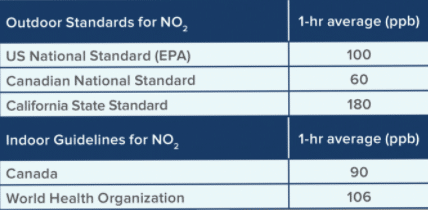Gas stoves continue to be a favorite with chefs and keen amateur cooks, but cooking with gas isn’t all sunshine and roses. Here’s everything you need to know about gas stoves and indoor air quality.
Table of Contents
If you’re ready to replace your old stove, you might consider breaking up with those burners, especially if the issue of indoor air quality is on your radar. Sure, there are some benefits to cooking with gas, but there’s also overwhelming evidence that gas appliances are a recipe for unhealthy indoor air that can harm your family’s health.
See also: The best indoor air quality monitors
Gas stoves and indoor air quality
Perhaps the biggest downside of gas cooking is its negative impact on indoor air quality. This is exacerbated if, like most, you don’t have an effective exhaust hood over your stove.
Several factors affect how gas stoves impact your indoor air quality. These include household airflow and outdoor levels of nitrogen dioxide (NO2) and carbon monoxide (CO).
Gas stoves emit both NO2 and CO, as well as formaldehyde (HCHO). All of these gases adversely affect health, with the potential to cause serious problems for anyone with asthma, emphysema, or any respiratory illness or health issue.
What the research says – gas stoves and indoor air quality
Homes with gas stoves have 50-400% higher concentrations of NO2 compared to homes with electric stoves. This is according to a report by the Rocky Mountain Institute.
Even more conservative calculations, courtesy of the Lawrence Berkeley National Laboratory and Stanford University, show that gas stoves add 25–33% to indoor NO2 concentrations during summer. In winter, gas stoves add 35–39% more NO2, because homes are typically less well ventilated.
Researchers from Lawrence Berkeley National Laboratory and Stanford University developed a simulation model to measure the effects of gas stoves on air quality.
This model is designed to estimate the likely exposure to noxious gases experienced by different household members when a gas stove is used in a typical fashion. The researchers factored in air flow in the house, outdoor levels of NO2 and CO, and even assumptions about the proximity of small children to adults cooking breakfast, lunch, or dinner.
The same research found that gas stoves increased carbon monoxide (CO) by 30% in summer and 21% in winter. (CO concentrations are lower outdoors in summer.) As for formaldehyde, gas stoves added relatively little to indoor air; the biggest contributions come from furniture and building materials. This shows that it’s smart to choose low-VOC building materials and furniture for your home.
Household exposure to toxic gases can quickly reach and exceed federal and California state health-based standards when you don’t have (and use!) a range hood to vent cooking fumes. During a typical winter week, 1.7 and 12 million Californians could be exposed to levels of carbon monoxide and nitrogen dioxide, respectively, that exceed indoor air quality standards if cooking with gas without a range hood.
Given the frequency of wildfires and outdoor air quality advisories in the state, this presents a significant public health issue in California. What’s more, small children, aged 0-5 in this model, were most at risk because of likely proximity to a parent or caregiver cooking a meal.
Free eBook: Simple Steps to a Greener Home
Concerned about climate change? Learn actionable tips for making each room in your home greener.
"*" indicates required fields

Gas stoves in the family home
In the same study as above, researchers found that small children, aged 0-5, were most at risk of adverse health effects of gas cooking. Unlike older children, younger kids are more likely to be close to a parent or caregiver cooking a meal.
Research suggests that children living in a home with a gas stove have about a 20% increased risk of developing a respiratory illness. One meta-analysis found that for every 15 ppb rise in NO2, a child’s risk of wheeze rose 15%.
Known potential health effects in children of exposure to indoor air pollutants from gas cooking include:
- Increased risk of asthma (lifetime and current)
- Learning deficits (especially in the first four years of life, and among genetically susceptible children)
- Cardiovascular problems
- Increased susceptibility to lung infections
- Increase susceptibility to allergens
- Changed lung function
- Aggravated respiratory symptoms (wheeze, difficulty breathing, cough, chest tightness).
What does this increased risk look like in practice though? Well, without proper ventilation, even baking a batch of muffins and using one burner on a gas stove can increase NO2 levels to twice the World Health Organization (WHO) guidelines for indoor air safety (106 ppb; 90 ppb in Canada; the EPA has no indoor air pollutant standards). The effects spread far beyond the kitchen, too. Other rooms of the house, including the nursery and kids’ bedrooms, can also be affected.
Indoor air quality regulations and gas stoves
Somewhat shockingly, given the evidence, gas stoves are the only major indoor gas appliance not required to be vented outdoors. If you have a gas furnace, dryer, or water heater, you have to vent these outside to satisfy regulations. This is because regulators have long acknowledged the danger they pose to indoor air quality and health.
This inequity in regulations isn’t because gas stoves are any safe than other gas appliances, however. Your gas stove burns just as much gas as a gas dryer, for instance. The cynic in me says that this lack of regulation is a product of intense lobbying by the natural gas industry, and marketing that uses social media influencers #CookingWithGas to play on our emotional attachment to gas stoves, which we just don’t have to, say, our gas furnace.
In the U.S. there are no current federal venting requirements for gas stoves in new buildings. Many states also lack regulations, though some are introducing regulations to support safe air quality.
In 2021, California developed new standards that, having been adopted in 2022, require more ventilation for gas stoves (versus electric) from January 1, 2023 onwards. The standards also require more robust ventilation in smaller apartments, given that indoor air pollutants reach higher levels faster in small spaces.
There are also plans afoot for federal government incentives to encourage people to switch from residential gas to all-electric, despite much opposition from the natural gas industry.
In 2015 in Canada, the government set indoor long-term exposure limits to NO2 at 11 parts per billion. This is one of the strictest limits in the world. There’s also a big push in my province (British Columbia) to encourage people to switch gas appliances for electric. This includes excellent rebates for heat pumps, hot water tanks as well as electric stoves.
Free eBook: Simple Steps to a Greener Home
Concerned about climate change? Learn actionable tips for making each room in your home greener.
"*" indicates required fields

The inequity of indoor air pollution
Sadly, and unsurprisingly, gas stove pollution is most likely to affect lower-income communities. There are several reasons for this, including poorer ventilation and less control over appliances in rental accommodation.
Many lower-income households also have higher indoor air pollution because people have to use their gas stove to heat the home. One 2008 survey found that 14% of 150 asthmatic children living in Baltimore lived in homes heated by a gas stove.
If you are a property owner renting out an apartment or home, consider supporting the health of your tenants by switching gas appliances for electric or induction. And if you’re building a new home from scratch, skip the expensive ventilation infrastructure needed for gas appliances and install all-electric from the start.
See Also – Air Pollution and Race: 5 Startling Facts
How to improve indoor air quality while cooking with gas
The easiest way to safeguard indoor air quality is to switch your gas stove for an energy-efficient induction range. Barring that, properly install and use an effective range hood. For the most effective ventilation, use the back burners with the range hood fan on and windows and doors open where possible.
If you’re wary of using a range hood that vents warm air outside, let the Scandinavians inspire you. Heat exchangers are common in Scandinavian countries, with range hoods reducing heat lost to the outdoors while eliminating unwanted fumes.
You might also consider installing a whole home HVAC system. Modern ventilation systems can quietly and quickly get rid of unwanted fumes and humidity while retaining heat.
When we moved into our current home, we realized that our range hood wasn’t actually vented outside. All it did was recirculate air! We prioritized installing ductwork to properly vent cooking fumes. This helps to get rid of air pollutants and helps with moisture management in our older home.
You can also make a big difference to indoor air quality by:
- Using safe, non-toxic cookware that is free of PTFE, PFOA, and PFOS
- Choosing cooking oils with an appropriate smoking point
- Not using the self-cleaning mode of ovens
OR
- Only using self-cleaning modes infrequently and only when vulnerable family members (including pets) are out.
Cleaning your oven with natural products and elbow grease will also save energy.
Finally, if you’re looking to replace a stove and want to stick with gas, choose a newer model with electric ignition. This type of gas stove uses up to 40% less gas than older models that have a pilot light that burns all day and night.
Thankfully, pilot lights were largely phased out after 1990, so unless you’re importing a model from outside the U.S. (and Europe), any new gas stove should have electric ignition.
Free eBook: Simple Steps to a Greener Home
Concerned about climate change? Learn actionable tips for making each room in your home greener.
"*" indicates required fields

The Inflation Reduction Act and rebates to switch away from gas
The Inflation Reduction Act, adopted into law in 2022, includes $4.5 billion in funding for states to provide rebates for residents purchasing new electric appliances, including electric and induction cooktops, wall ovens, and ranges.
This program operates through the Department of Energy, which allocates funds to each state for distribution as it sees fit (but within the DoE’s guidelines).
Per the program, consumers could qualify for up to $1,340 in rebates on a new electric or induction stove if switching from gas or propane. Even if you’re replacing an existing electric stove or range, you could qualify for up to $840 in rebates.
Note, though, that switching from gas to electric may require upgrades to your home’s wiring. The good news is that there are rebates for that too! The IRA offers a tax credit of up to $4,000 to upgrade the breaker box and up to $2,500 in credits for upgrading wiring. So, if you don’t have a 220 Volt outlet, don’t let that stop you getting an induction stove for a few hundred dollars (after rebates). Check out the tax credit at Rewiring America for more information.
Check out our top choices for ranges with an induction cooktop here.
